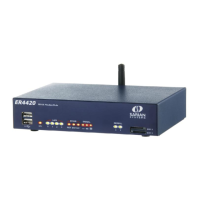Configure Advanced interfaces settings
Digi TransPort User Guide 316
Request local PAP authentication
When enabled, causes the router to use the Password Authentication Protocol (PAP) before
allowing a connection to be made. Generally, this parameter is enabled for incoming
connections and disabled for outgoing connections.
Request remote PAP authentication
When enabled, causes the router to authenticate itself with the remote device using PAP. If
this parameter is set, the connection will fail if authentication is not successful. Generally, this
parameter is disabled.
Request local CHAP authentication
When enabled, causes the router to use the Challenge Handshake Authentication Protocol
(CHAP) for local authentication. As with PAP, this parameter is generally enabled for incoming
connections and disabled for outgoing connections.
Request remote CHAP authentication
As with PAP above, this checkbox controls whether or not the router should authenticate itself
with the remote device using CHAP. The connection will fail if authentication fails. Generally,
this parameter is enabled for outgoing connection and disabled for inbound connections.
Request local (VJ) compression
When enabled, causes the router to request the use of Van Jacobson compression which
compresses TCP/IP headers to about 3 octets, rather than the standard 40 octets. This is
generally only used to improve efficiency on slow links.
Request remote (VJ) compression
When enabled, causes the router to send a negotiation packet that requests that the remote
device requests VJ compression.
Request local PFC
When enabled, causes the router to request Protocol Field Compression (PFC) which
compresses PPP protocol fields from 2 octets to 1 octet.
Request remote PFC
When enabled, causes the router to ask the remote device to request Protocol Field
Compression.
Request BACP
When enabled, the router will use the Bandwidth Allocation Control Protocol (BACP) to
determine the ISDN number to dial for the seconds or third multi-link connection.
Request callback
When enabled, requests a callback when it dials into a remote device. The answering PPP
instance of the remote router must also be configured with the telephone number of the
calling router and a suitable username, password combination.

